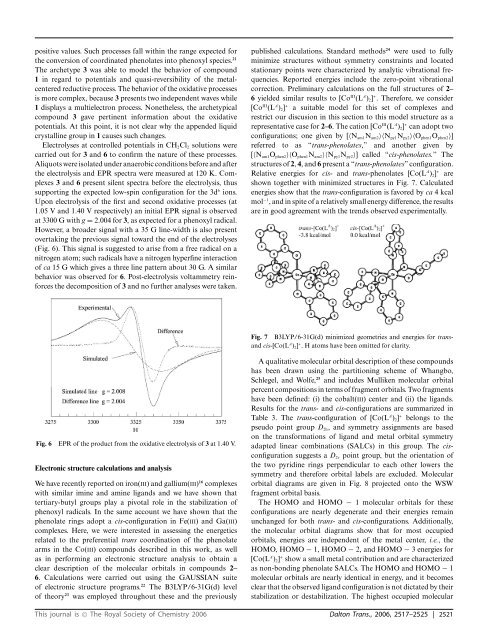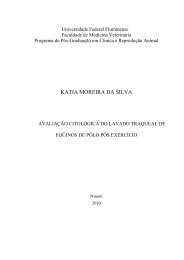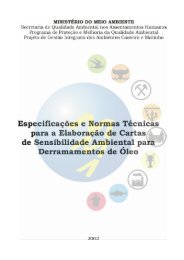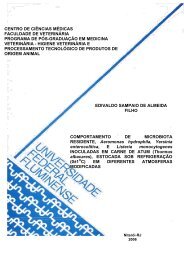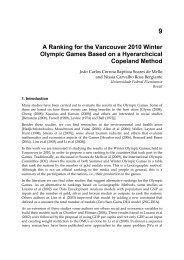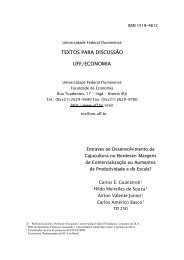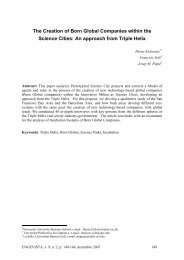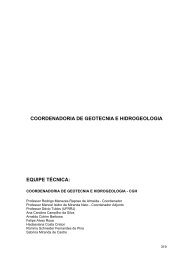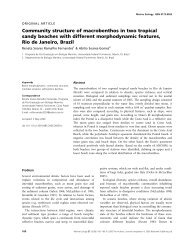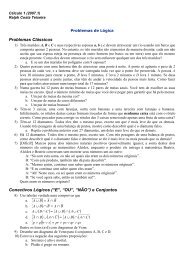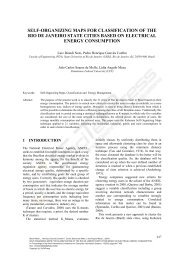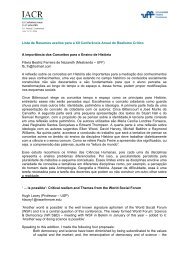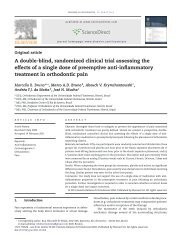Structural, spectroscopic, and electrochemical behavior of trans - UFF
Structural, spectroscopic, and electrochemical behavior of trans - UFF
Structural, spectroscopic, and electrochemical behavior of trans - UFF
You also want an ePaper? Increase the reach of your titles
YUMPU automatically turns print PDFs into web optimized ePapers that Google loves.
positive values. Such processes fall within the range expected for<br />
the conversion <strong>of</strong> coordinated phenolates into phenoxyl species. 21<br />
The archetype 3 was able to model the <strong>behavior</strong> <strong>of</strong> compound<br />
1 in regard to potentials <strong>and</strong> quasi-reversibility <strong>of</strong> the metalcentered<br />
reductive process. The <strong>behavior</strong> <strong>of</strong> the oxidative processes<br />
is more complex, because 3 presents two independent waves while<br />
1 displays a multielectron process. Nonetheless, the archetypical<br />
compound 3 gave pertinent information about the oxidative<br />
potentials. At this point, it is not clear why the appended liquid<br />
crystalline group in 1 causes such changes.<br />
Electrolyses at controlled potentials in CH 2 Cl 2 solutions were<br />
carried out for 3 <strong>and</strong> 6 to confirm the nature <strong>of</strong> these processes.<br />
Aliquots were isolated under anaerobic conditions before <strong>and</strong> after<br />
the electrolysis <strong>and</strong> EPR spectra were measured at 120 K. Complexes<br />
3 <strong>and</strong> 6 present silent spectra before the electrolysis, thus<br />
supporting the expected low-spin configuration for the 3d 6 ions.<br />
Upon electrolysis <strong>of</strong> the first <strong>and</strong> second oxidative processes (at<br />
1.05 V <strong>and</strong> 1.40 V respectively) an initial EPR signal is observed<br />
at 3300 G with g = 2.004 for 3, as expected for a phenoxyl radical.<br />
However, a broader signal with a 35 G line-width is also present<br />
overtaking the previous signal toward the end <strong>of</strong> the electrolyses<br />
(Fig. 6). This signal is suggested to arise from a free radical on a<br />
nitrogen atom; such radicals have a nitrogen hyperfine interaction<br />
<strong>of</strong> ca 15 G which gives a three line pattern about 30 G. A similar<br />
<strong>behavior</strong> was observed for 6. Post-electrolysis voltammetry reinforces<br />
the decomposition <strong>of</strong> 3 <strong>and</strong> no further analyses were taken.<br />
published calculations. St<strong>and</strong>ard methods 24 were used to fully<br />
minimize structures without symmetry constraints <strong>and</strong> located<br />
stationary points were characterized by analytic vibrational frequencies.<br />
Reported energies include the zero-point vibrational<br />
correction. Preliminary calculations on the full structures <strong>of</strong> 2–<br />
6 yielded similar results to [Co III (L A ) 2 ] + . Therefore, we consider<br />
[Co III (L A ) 2 ] + a suitable model for this set <strong>of</strong> complexes <strong>and</strong><br />
restrict our discusion in this section to this model structure as a<br />
representative case for 2–6. The cation [Co III (L A ) 2 ] + can adopt two<br />
configurations; one given by [〈N am1 N am2 〉〈N py1 N py2 〉〈O phen1 O phen2 〉]<br />
referred to as “<strong>trans</strong>-phenolates,” <strong>and</strong> another given by<br />
[〈N am1 O phen2 〉〈O phen1 N am2 〉〈N py1 N py2 〉] called “cis-phenolates.” The<br />
structures <strong>of</strong> 2, 4,<strong>and</strong>6 present a “<strong>trans</strong>-phenolates” configuration.<br />
Relative energies for cis- <strong>and</strong> <strong>trans</strong>-phenolates [Co(L A ) 2 ] + are<br />
shown together with minimized structures in Fig. 7. Calculated<br />
energies show that the <strong>trans</strong>-configuration is favored by ca 4kcal<br />
mol −1 , <strong>and</strong> in spite <strong>of</strong> a relatively small energy difference, the results<br />
are in good agreement with the trends observed experimentally.<br />
Fig. 7 B3LYP/6-31G(d) minimized geometries <strong>and</strong> energies for <strong>trans</strong><strong>and</strong><br />
cis-[Co(L A ) 2 ] + . H atoms have been omitted for clarity.<br />
Fig. 6 EPR <strong>of</strong> the product from the oxidative electrolysis <strong>of</strong> 3 at 1.40 V.<br />
Electronic structure calculations <strong>and</strong> analysis<br />
We have recently reported on iron(III) <strong>and</strong> gallium(III) 16 complexes<br />
with similar imine <strong>and</strong> amine lig<strong>and</strong>s <strong>and</strong> we have shown that<br />
tertiary-butyl groups play a pivotal role in the stabilization <strong>of</strong><br />
phenoxyl radicals. In the same account we have shown that the<br />
phenolate rings adopt a cis-configuration in Fe(III) <strong>and</strong> Ga(III)<br />
complexes. Here, we were interested in assessing the energetics<br />
relatedtothepreferential<strong>trans</strong> coordination <strong>of</strong> the phenolate<br />
arms in the Co(III) compounds described in this work, as well<br />
as in performing an electronic structure analysis to obtain a<br />
clear description <strong>of</strong> the molecular orbitals in compounds 2–<br />
6. Calculations were carried out using the GAUSSIAN suite<br />
<strong>of</strong> electronic structure programs. 22 The B3LYP/6-31G(d) level<br />
<strong>of</strong> theory 23 was employed throughout these <strong>and</strong> the previously<br />
A qualitative molecular orbital description <strong>of</strong> these compounds<br />
has been drawn using the partitioning scheme <strong>of</strong> Whangbo,<br />
Schlegel, <strong>and</strong> Wolfe, 25 <strong>and</strong> includes Mulliken molecular orbital<br />
percent compositions in terms <strong>of</strong> fragment orbitals. Two fragments<br />
have been defined: (i) the cobalt(III) center <strong>and</strong> (ii) the lig<strong>and</strong>s.<br />
Results for the <strong>trans</strong>- <strong>and</strong>cis-configurations are summarized in<br />
Table 3. The <strong>trans</strong>-configuration <strong>of</strong> [Co(L A ) 2 ] + belongs to the<br />
pseudo point group D 2h , <strong>and</strong> symmetry assignments are based<br />
on the <strong>trans</strong>formations <strong>of</strong> lig<strong>and</strong> <strong>and</strong> metal orbital symmetry<br />
adapted linear combinations (SALCs) in this group. The cisconfiguration<br />
suggests a D 2v point group, but the orientation <strong>of</strong><br />
the two pyridine rings perpendicular to each other lowers the<br />
symmetry <strong>and</strong> therefore orbital labels are excluded. Molecular<br />
orbital diagrams are given in Fig. 8 projected onto the WSW<br />
fragment orbital basis.<br />
The HOMO <strong>and</strong> HOMO − 1 molecular orbitals for these<br />
configurations are nearly degenerate <strong>and</strong> their energies remain<br />
unchanged for both <strong>trans</strong>- <strong>and</strong>cis-configurations. Additionally,<br />
the molecular orbital diagrams show that for most occupied<br />
orbitals, energies are independent <strong>of</strong> the metal center, i.e., the<br />
HOMO, HOMO − 1, HOMO − 2, <strong>and</strong> HOMO − 3 energies for<br />
[Co(L A ) 2 ] + show a small metal contribution <strong>and</strong> are characterized<br />
as non-bonding phenolate SALCs. The HOMO <strong>and</strong> HOMO − 1<br />
molecular orbitals are nearly identical in energy, <strong>and</strong> it becomes<br />
clear that the observed lig<strong>and</strong> configuration is not dictated by their<br />
stabilization or destabilization. The highest occupied molecular<br />
This journal is © The Royal Society <strong>of</strong> Chemistry 2006 Dalton Trans., 2006, 2517–2525 | 2521


